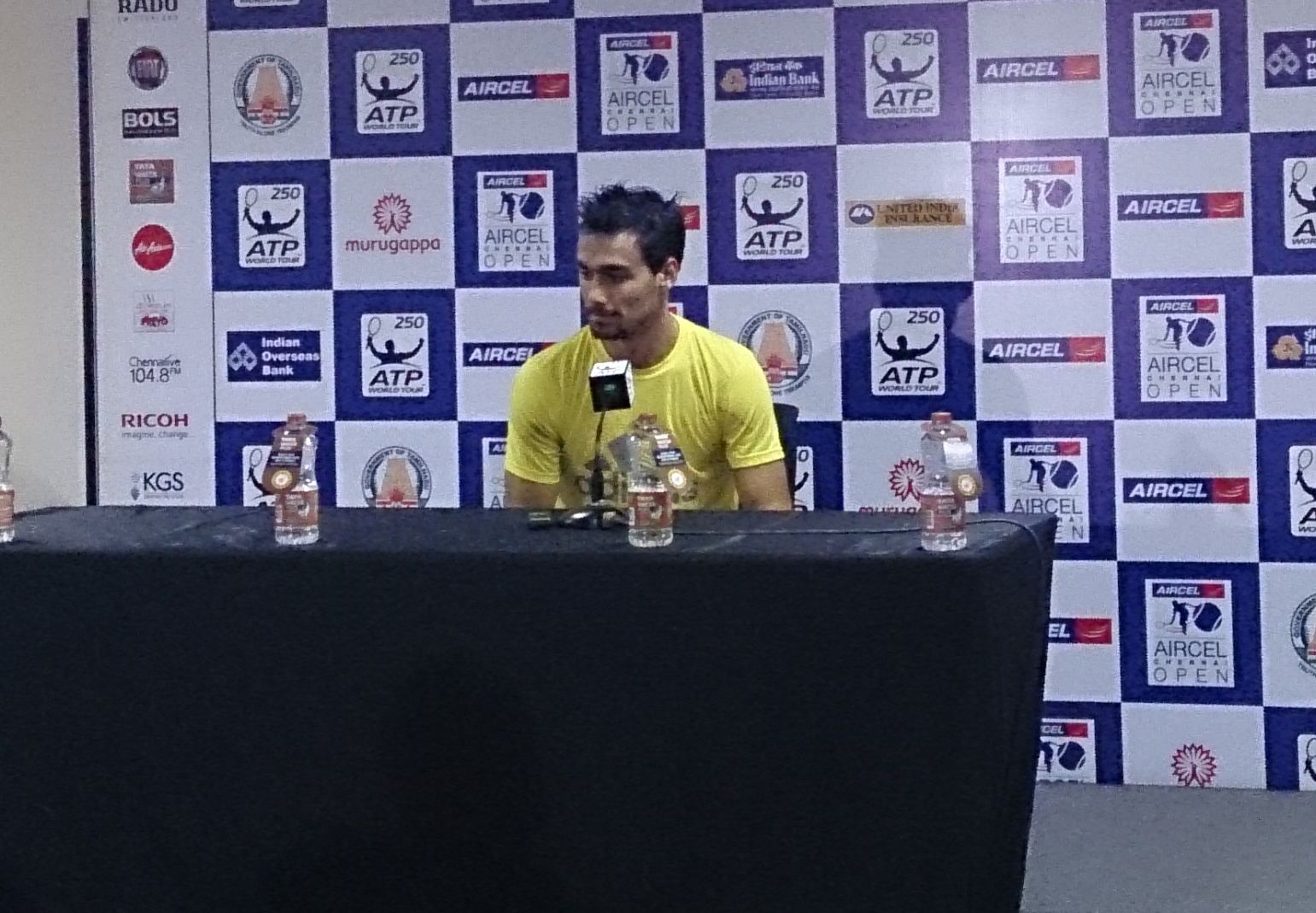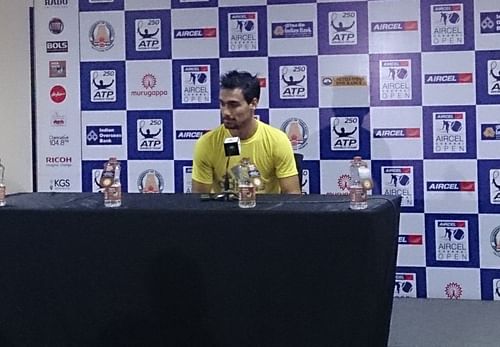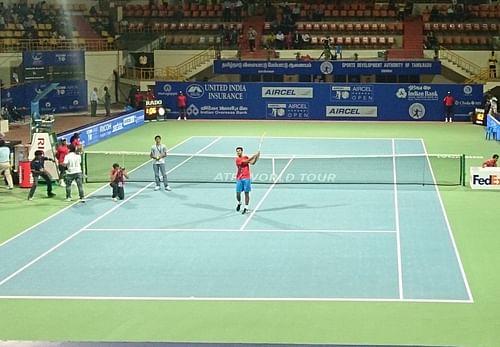
Aircel Chennai Open Day 4: Yuki Bhambri and Fabio Fognini pose some existential questions

Fabio Fognini at his post-match press conference
If you can’t sympathize with a player who has retired from a match, does that make you a bad person?
Fabio Fognini made a lot of people attending Day 4 of the Aircel Chennai Open ask themselves that existential question with his on-court actions. The Italian was trailing 1-6, 5-5 against India’s own Yuki Bhambri when he realized he couldn’t continue playing any longer, handing Bhambri the match and a place in his first ever ATP quarterfinal.
Ordinarily, it would have been a simple case of a mid-match retirement bringing about an unfortunate but unavoidable conclusion to a promising encounter. Mikhail Youzhny retiring from his match against Dudi Sela after four games yesterday was, for instance, a classic example of a disappointing result that was hard to watch but easy to accept. However, when Fognini walked up to the umpire today to announce his decision to withdraw from the match, not only did you feel that it was an inevitable turn of events, you also wondered why he had bothered to show up on the court at all.
A little background information would be in order here. Two days ago Fognini had pulled out of the doubles tournament (in which he was paired with Leander Paes), citing a left quad injury. There were immediate suspicions that he’d pull out of the singles draw too, but no announcement was forthcoming from the Fognini camp, and yesterday he even spent some time on the practice courts, during which he looked in fairly good shape.
His match against Bhambri today had question marks all over it; the official schedule listed the match as the first encounter on Centre Court, but the press notes mentioned that a final verdict on the occurrence of the match was still awaited. It wasn’t until he actually entered the arena at the scheduled start time that everyone was convinced the match would indeed take place. It was a bit of a surprise to see Fognini walking up for the coin toss, to be honest, but a decidedly pleasant surprise.
When the match started, Bhambri looked sharp, and Fognini…well, it’s hard to really describe how he looked. The Italian’s game is known for having a deceptively casual appearance; a lot of times in the past he has turned a point upside down with a nonchalant baseline blast that he delivers while standing stock still, with little to no footwork. That happened several times during today’s match too; just when you thought Bhambri had turned the point in his favour, Fognini would dramatically slap the ball and produce a stone cold winner out of nowhere. But just as frequent as these unexpected winners were his random errors; there was no rhythm to his play whatsoever, and nobody in the stadium had much of a clue what to make of it all.
The sceptre of retirement remained at the back of everyone’s mind. As Fognini oscillated between belting an outrageous winner and unfurling a cringe-worthy error, you couldn’t help but wonder whether his erratic play was the result of his injury or just plain laziness. His frequent glances at his player box didn’t help, not least because they were singularly confusing in themselves; sometimes he’d just smile at his entourage, sometimes he’d mutter at them angrily, and sometimes he’d laugh. It was impossible to decipher whether he was looking for encouragement from his team, or simply venting his frustration at them.
Serving at 1-2, break point down in the first set, Fognini was confronted with a mediocre dropshot from Bhambri; instead of chasing it down, however, he let it go, thus giving up the break. The match seemed to teeter on the brink right then; was this the sign that the Italian needed to call it a day? But he didn’t take it as one, and Bhambri proceeded to play an awful game that saw him concede a bunch of break points through careless errors. He saved them all, however, taking a 4-1 lead, which pretty much signalled the end of Fognini’s fight for the set.
The second set was more competitive, but it wouldn’t have been so if Bhambri hadn’t had another lapse of concentration after getting the early break. This time he did get broken, bringing the score level at 3-3, after which there would be no more breaks in the match. But Fognini kept the crowd entertained with his shenanigans all through the set.
At 2-2, after he missed a first serve, a small section of the crowd started shouting Bhambri’s name a little too loudly. The umpire promptly issued them a warning, but that wasn’t enough for Fognini. He dramatically waved his hands in their direction and back at the umpire, complaining loudly about the loss in concentration they were causing. He wasn’t wrong about that last bit; visibly upset, he missed the second serve by a big margin to cough up a break point, and he was broken soon after, which he followed immediately with a medical timeout.
Even after getting the break back, Fognini seemed completely out of it the last few games. Wandering around the court during changeovers instead of heading straight for his chair, he looked seriously lost. After taking a few steps in different directions, he would trudge back to his chair, dragging his feet and looking as though he’d rather be anywhere but on the court. When play would resume he would again go for broke and pull the trigger early in every rally, ending the point with either a winner or an error, and almost invariably following the error with a scowl at his player box. Fognini managed the difficult task of appearing both disinterested and tortured at the same time.
The Italian brought that confused, preoccupied air to the post-match press conference too. He didn’t seem sure about anything that was asked of him – he said he wasn’t sure how long his injury would take to heal, he had no idea whether he’d play in the Australian Open, and he didn’t really know what caused his injury to flare up again during the match after it had seemingly gotten better the last couple of days. Admittedly, it’s hard for a player to ever truly know the exact extent of his injury, but in Fognini’s case, he didn’t even seem interested in finding that out. Or maybe it just appeared that way to us because of what we saw from him on the court.

Yuki Bhambri doing the customary act of hitting the ball into the stands after his victory
While all of that was happening on Fognini’s side of the court, Bhambri kept his nose to the ground and stuck to his plans, which is truly commendable for a player of his age. His preferred forehand wing was on song all through the match, and he served well too, which kept Fognini perpetually on his toes while returning. Like his fellow breakout star Ramkumar Ramanathan (who later lost to Marcel Granollers 6-2, 6-4), Bhambri’s backhand will probably always remain a liability. But unlike Ramanathan, Bhambri seems to have accurately pigeonholed the problem, and found a way to make it a solid, dependable shot, if not a weapon.
Still, the Bhambri backhand was a hot topic of discussion at the press conference. At one point a reporter flatly asked him, “What are you doing about your backhand?” Bhambri didn’t quite seem to know how to react to that, and stared blankly at the questioner for a couple of seconds, before recovering and affirming that he was doing everything in his power to make it more of a weapon, and that it had improved considerably over the past one year.
Bhambri also sounded bullish about the other improvements in his game, and was particularly happy about the way his net game had shaped up. He dispelled the notion that Indians are ‘afraid of approaching the net’, and declared that the reason why Indian players don’t come to the net too frequently is the same reason why players from the rest of the world don’t: modern racquet technology and court slowness simply don’t allow that. Bhambri asserted that he himself would continue making regular forays to the net; his game was fundamentally offense-based, he claimed, and if he used his forehand well enough he would always have a lot of opportunities to attack behind it and finish points early.
From where I watched, however, what was more worrying than his backhand was the way Bhambri semi-choked after getting the break in both the sets. In the first set he managed to avert the threat, but in the second set he didn’t. It doesn’t take rocket science to realize that he won’t get so many chances to close out sets in matches against the very top players.
Bhambri recognized the problem, and confessed that he started resorting to ‘playing safe’ once he had the lead. Remaining aggressive is the key, he said, and he added that he’d have to do a better job of going for his shots while leading in the future. That’s easier said than done, of course, but it’s good to know that Bhambri has a plan in place to counter all of his deficiencies.
The mature, composed way in which Bhambri handled all the events of the day made us ask an existential question too: are professional athletes the best teachers of problem-solving?
I don’t know about you, but I’d much rather answer Bhambri’s existential question than Fognini’s.